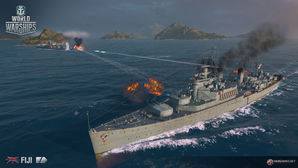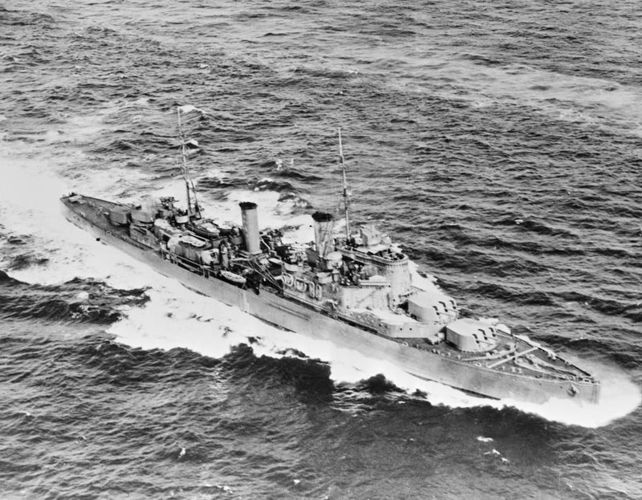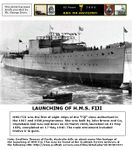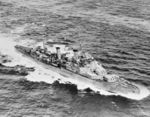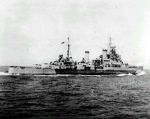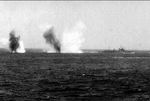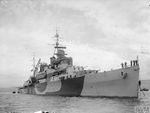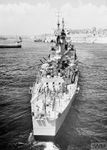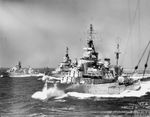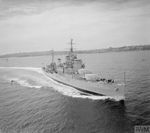Fiji
| Revision as of 11:09, 11 April 2018 | Revision as of 11:00, 20 April 2018 | |||
| Line 203: | Line 203: | |||
| Other features of the Crown Colony-class that differed from the Town-class was the use of straight funnels and masts, as opposed to the raked ones found on the Town-class, and the use of a transom stern. The after fire control position was mounted on the top of X-turret, as the more conventional position was found to be untenable when the after turrets fired towards the forward limits of their arcs. As a result of the armament on such a small hull, the ships proved very cramped and overcrowded in wartime conditions. | Other features of the Crown Colony-class that differed from the Town-class was the use of straight funnels and masts, as opposed to the raked ones found on the Town-class, and the use of a transom stern. The after fire control position was mounted on the top of X-turret, as the more conventional position was found to be untenable when the after turrets fired towards the forward limits of their arcs. As a result of the armament on such a small hull, the ships proved very cramped and overcrowded in wartime conditions. | |||
| ? | The second group of the Crown Colony-class, the ''Ceylon'' sub-class, restored the 80,000 shaft horsepower machinery of the Town-class and thus the top speed. This was achieved at the expense of X-turret, reducing the main armament to nine 152mm rifles, but this change enhanced the ships anti-aircraft outfit and eased living conditions for the crews, making them less cramped. The X-turret was removed from the ''Fiji'' sub-class | + | The second group of the Crown Colony-class, the ''Ceylon'' sub-class, restored the 80,000 shaft horsepower machinery of the Town-class and thus the top speed. This was achieved at the expense of X-turret, reducing the main armament to nine 152mm rifles, but this change enhanced the ships anti-aircraft outfit and eased living conditions for the crews, making them less cramped. The X-turret was removed from the ''Fiji'' sub-class as allowed later in the second world war, except for ''Nigeria'' where it was removed in 1954. | |
| Although HMS ''Nigeria'' was laid down first, ''Fiji'' was launched and commissioned first, and hence gave her name to the first sub-class of the Crown Colony-class. | Although HMS ''Nigeria'' was laid down first, ''Fiji'' was launched and commissioned first, and hence gave her name to the first sub-class of the Crown Colony-class. | |||
| Line 210: | Line 210: | |||
| HMS ''Fiji'' was commissioned on 5 May 1940, and was assigned to the Home Fleet where she participated in the blockade of German-controlled Europe and escorted convoys. She was due to take part in Operation Menace, the attack on Dakar, but she was hit by a torpedo from submarine ''U-32'', which necessitated 6 months of repairs. In early 1941, after patrolling the Denmark Strait for the German raider ''Admiral Scheer'', she was transferred to Force H, this time operating off the west coast of France as well as performing convoy escort duties on the Malta route. In May 1941, during the battle and evacuation of Crete, ''Fiji'' was tasked with covering the rescue of survivors from the destroyer HMS ''Greyhound'', along with 2 other destroyers and the Town-class HMS ''Gloucester''. However, low on anti-aircraft ammunition, the ships were attacked, and ''Fiji'' sustained 4 bomb hits, which slowed her and eventually caused her to capsize on 22 May 1941. 523 survivors were picked up. | HMS ''Fiji'' was commissioned on 5 May 1940, and was assigned to the Home Fleet where she participated in the blockade of German-controlled Europe and escorted convoys. She was due to take part in Operation Menace, the attack on Dakar, but she was hit by a torpedo from submarine ''U-32'', which necessitated 6 months of repairs. In early 1941, after patrolling the Denmark Strait for the German raider ''Admiral Scheer'', she was transferred to Force H, this time operating off the west coast of France as well as performing convoy escort duties on the Malta route. In May 1941, during the battle and evacuation of Crete, ''Fiji'' was tasked with covering the rescue of survivors from the destroyer HMS ''Greyhound'', along with 2 other destroyers and the Town-class HMS ''Gloucester''. However, low on anti-aircraft ammunition, the ships were attacked, and ''Fiji'' sustained 4 bomb hits, which slowed her and eventually caused her to capsize on 22 May 1941. 523 survivors were picked up. | |||
| ? | HMS ''Nigeria'' was commissioned in September 1940 and was also assigned to the Home fleet. There she spent the majority of her early war service performing convoy escort duties in the North Atlantic and Arctic. In June 1941, she intercepted the German weather ship ''Lauenburg'', and recovered parts of an enigma machine and code books before the ship sank. The next month, ''Fiji'' operated in the Arctic, sinking the German training ship ''Bremse'' off Norway, though she received damage to her bows, possibly from a mine, and required repairs. By August 1942, repairs were complete, and ''Nigeria'' was sent to the Mediterranean to provide escort for the Malta convoy; Operation Pedestal. However she was torpedoed and damaged by the Italian submarine ''Axum'' during the battle and sent to the US for repairs. ''Nigeria'' operated in the South Atlantic in 1943, and joined ''Kenya'' with the British Pacific Fleet in 1944, taking part in operations against the Japanese. ''Nigeria'' was the only ''Fiji'' sub-class to retain X-turret. Her post-war service station was the South Atlantic until 1950, when she was placed in reserve. In 1954, ''Nigeria'' was sold to India where she was renamed ''Mysore''. ''Mysore'' served in the Indian Navy until the 1980's when she was finally decommissioned and scrapped. | + | HMS ''Nigeria'' was commissioned in September 1940 and was also assigned to the Home fleet. There she spent the majority of her early war service performing convoy escort duties in the North Atlantic and Arctic. In June 1941, she intercepted the German weather ship ''Lauenburg'', and recovered parts of an enigma machine and code books before the ship sank. The next month, ''Fiji'' operated in the Arctic, sinking the German training ship ''Bremse'' off Norway, though she received damage to her bows, possibly from a mine, and required repairs. By August 1942, repairs were complete, and ''Nigeria'' was sent to the Mediterranean to provide escort for the Malta convoy; Operation Pedestal. However she was torpedoed and damaged by the Italian submarine ''Axum'' during the battle and sent to the US for repairs. ''Nigeria'' operated in the South Atlantic in 1943, and joined ''Kenya'' with the British Pacific Fleet in 1944, taking part in operations against the Japanese. ''Nigeria'' was the only ''Fiji'' sub-class to retain X-turret post war, until it's removal in 1954. Her post-war service station was the South Atlantic until 1950, when she was placed in reserve. In 1954, ''Nigeria'' was sold to India where she was renamed ''Mysore''. ''Mysore'' served in the Indian Navy until the 1980's when she was finally decommissioned and scrapped. | |
| HMS ''Kenya'' was also commissioned in September 1940 and assigned to the Home Fleet. She performed convoy escort duties in the North Atlantic, but in May 1941 was tasked, along with the rest of her squadron, with hunting the ''[[Bismarck]]'' and her supply ships, one of which, the ''Belchen'' was caught by ''Kenya''. In October 1941, she sank the German blockade runner ''Kota Pinang'' off Cape Finisterre. ''Kenya'' then served a short tour in the Mediterranean before departing again for the North Atlantic and Arctic waters. There she participated in operations against German ships and installations on the Norwegian coast until mid-1942. Deployed to the Mediterranean again to take part in the Malta convoys; Operations Harpoon and Pedestal, ''Kenya'' was torpedoed by the Italian submarine ''Alagi'' during Pedestal, and returned to the UK for repairs until the end of 1942. From 1943 to the end of the war, ''Kenya'' accompanied the British Pacific Fleet as it conducted raids through the East Indies and into the Central Pacific. Post-war, ''Kenya'' was assigned to the Americas until she was placed in reserve during the final years of the decade. ''Kenya'' was reactivated for the Korean War, and joined Royal Navy forces there. After the war, Kenya again served in the Americas, the Mediterranean, and the Atlantic before once again being placed in reserve in 1958. ''Kenya'' was sold for scrapping in 1962. | HMS ''Kenya'' was also commissioned in September 1940 and assigned to the Home Fleet. She performed convoy escort duties in the North Atlantic, but in May 1941 was tasked, along with the rest of her squadron, with hunting the ''[[Bismarck]]'' and her supply ships, one of which, the ''Belchen'' was caught by ''Kenya''. In October 1941, she sank the German blockade runner ''Kota Pinang'' off Cape Finisterre. ''Kenya'' then served a short tour in the Mediterranean before departing again for the North Atlantic and Arctic waters. There she participated in operations against German ships and installations on the Norwegian coast until mid-1942. Deployed to the Mediterranean again to take part in the Malta convoys; Operations Harpoon and Pedestal, ''Kenya'' was torpedoed by the Italian submarine ''Alagi'' during Pedestal, and returned to the UK for repairs until the end of 1942. From 1943 to the end of the war, ''Kenya'' accompanied the British Pacific Fleet as it conducted raids through the East Indies and into the Central Pacific. Post-war, ''Kenya'' was assigned to the Americas until she was placed in reserve during the final years of the decade. ''Kenya'' was reactivated for the Korean War, and joined Royal Navy forces there. After the war, Kenya again served in the Americas, the Mediterranean, and the Atlantic before once again being placed in reserve in 1958. ''Kenya'' was sold for scrapping in 1962. | |||
| Line 227: | Line 227: | |||
| * In game, ''Fiji'' has a 114mm main belt, while it was only 89mm historically. This increase can be explained by the addition of the 25mm backing plate into the belt armor value. | * In game, ''Fiji'' has a 114mm main belt, while it was only 89mm historically. This increase can be explained by the addition of the 25mm backing plate into the belt armor value. | |||
| * ''Fiji'' uses the armor values for the Mk.XXIII turrets from ''[[Edinburgh]]'', the actual values for ''Fiji'''s Mk.XXIII turrets were 51mm for the front, and 25mm elsewhere. | * ''Fiji'' uses the armor values for the Mk.XXIII turrets from ''[[Edinburgh]]'', the actual values for ''Fiji'''s Mk.XXIII turrets were 51mm for the front, and 25mm elsewhere. | |||
| ? | * The 51mm deck armor of ''Fiji'' is | + | * The 51mm deck armor of ''Fiji'' is not observable and may not be present. | |
| * Both Hull (A) and Hull (B) have completely fictional anti-aircraft armament. No cruiser of the ''Fiji'' sub-class ever carried octuple 40mm 'pom-poms' or quadruple 40mm Bofors. The smaller guns are very loosely based off of various conditions of HMS ''Kenya'', but are not consistent. | * Both Hull (A) and Hull (B) have completely fictional anti-aircraft armament. No cruiser of the ''Fiji'' sub-class ever carried octuple 40mm 'pom-poms' or quadruple 40mm Bofors. The smaller guns are very loosely based off of various conditions of HMS ''Kenya'', but are not consistent. | |||
| * ''Fiji''’s actual anti-aircraft complement at the time of her sinking were four twin 4-inch (102 mm) dual-purpose guns, two quadruple 40 mm Vickers pom-pom guns and four quadruple 12.7 mm Vickers machine guns. | * ''Fiji''’s actual anti-aircraft complement at the time of her sinking were four twin 4-inch (102 mm) dual-purpose guns, two quadruple 40 mm Vickers pom-pom guns and four quadruple 12.7 mm Vickers machine guns. | |||
Revision as of 11:00, 20 April 2018
| 152 mm/50 BL Mk.XXIII on a Mk.XXIII mount4 х 3 pcs. |
| Rate of Fire7.5 shots/min. |
| Reload Time8 sec. |
| Rotation Speed7 deg./sec. |
| 180 Degree Turn Time25.71 sec. |
| Firing Range13.97 km. |
| Maximum Dispersion129 m. |
| Chance of Fire on Target Caused by HE Shell0 % |
| AP Shell152 mm AP 6crh Mk IV |
| Maximum AP Shell Damage3,100 |
| Initial AP Shell Velocity841 m./s. |
| AP Shell Weight50.8 kg. |
| 102 mm/45 QF Mk.XVI on a Mk.XIX mount4 х 2 pcs. |
| Firing Range5.6 km. |
| Rate of Fire20 shots/min. |
| Reload Time3 sec. |
| HE Shell102 mm HE 35 lb |
| Maximum HE Shell Damage1,500 |
| Initial HE Shell Velocity811 m./s. |
| Chance of Fire on Target Caused by HE Shell6 % |
| 533 mm TR Mk IV2 х 3 pcs. |
| Rate of Fire0.83 shots/min. |
| Reload Time72 sec. |
| Rotation Speed25 deg./sec. |
| 180 Degree Turn Time7.2 sec. |
| Torpedo533 mm Mk IX |
| Maximum Damage15,433 |
| Torpedo Speed61 knot |
| Torpedo Range8.01 km. |
| 102 mm/45 QF Mk.XVI on a Mk.XIX mount4 х 2 pcs. |
| . . . Average Damage per Second37.6 |
| . . . Firing Range5.01 km. |
| 20 mm Oerlikon Mk.I on a Mk.IIA mount5 х 1 pcs. |
| . . . Average Damage per Second18 |
| . . . Firing Range2.01 km. |
| 20 mm Oerlikon Mk.II on a Mk.V mount6 х 2 pcs. |
| . . . Average Damage per Second36.6 |
| . . . Firing Range2.01 km. |
| 40 mm/39 Vickers QF Mk.VIII on a Mk.VI mount2 х 8 pcs. |
| . . . Average Damage per Second39.6 |
| . . . Firing Range2.49 km. |
| Maximum Speed32.5 knot |
| Turning Circle Radius670 m. |
| Rudder Shift Time12.1 sec. |
| Surface Detectability Range11.17 km. |
| Air Detectability Range6.44 km. |
Fiji — British Tier VII cruiser.
A further development of a multi-purpose cruiser ship for the Royal Navy. Despite the fact that the ship's displacement was limited by international treaties, she carried numerous rapid-firing main guns.
Modules
Compatible Upgrades
| Slot 1 |
||||||
|---|---|---|---|---|---|---|
| Slot 2 |
||||||
| Slot 3 |
||||||
| Slot 4 |
Player Opinion
Performance
If Tier VI's Leander is considered "settling in" to the back half of the British cruiser line, then the best advice for captains embarking aboard Tier VII's Fiji for the first time is "buckle up and enjoy the ride".
Fiji maintains the branch's theme of 152mm main battery rifles, but moves up to mounting twelve of them in four triple-barrel turrets. As such, she is considerably up-gunned from Leander, and successors Edinburgh and Neptune boast identical configurations. At eight rounds per minute (a 7.5 second reload time), her main battery boasts the best rate of fire of all Tier VII cruisers, and she retains the 8.0 km maximum torpedo range of Leander’s upgraded torpedoes. Her unique mix of main battery and longer range torpedoes allow Fiji to hang in fights with equal-tier cruisers of other nations, and maintains her as a threat to enemy destroyers who wander too close.
First-time Fiji captains may think that she feels big for a light cruiser, and they're right. She has an increased beam over Leander, which allowed her designers to fit triple-barreled turrets on her hull. There's a subsequent increase to her detection radius, but she retains most of Leander’s handling characteristics; Fiji’s turning circle is tighter, and her rudder shift is — for all intents and purposes — the same. Her anti-aircraft suite is satisfactory if unremarkable, and is approximately on par with German counterpart Yorck.
Despite the British cruiser reputation for light armor, Fiji's belt armor is a surprisingly respectable 114 mm — much better than fellow Tier VII cruisers Pensacola and Shchors, and at least competitive with the rest — and can bounce a surprising amount of shells when angled. However, her citadel is long and her athwartship armor is quite weak, so it is still inadvisable to attempt to bow-tank.
Just like Leander, Fiji works best with friendly ships around. She's ideal for backing up allied destroyers, though can even cause significant damage to battleships in right situations. Nonetheless, if kept in combat where she is able to maximize her strengths against enemy cruisers and destroyers, she is an exceptional ship in the hands of the right captain.Pros:
- Good main battery range (15.4 km fully upgraded).
- Highly effective against enemy cruisers and destroyers.
- Guns can devastate enemy battleships if stealth can be maintained.
- Retains access to the Repair Party
 consumable.
consumable.
- Excellent main battery guns in a user-friendly layout.
- Below average detection range (i.e. good stealth).
- Excellent handling characteristics; quick rudder shift and tight turning circle.
- Best belt armor in the line, especially for her tier.
Cons:
- Long citadel and weak athwartship armor.
- Fairly ineffective against angled enemy battleships.
- Anti-aircraft suite is merely average.
- Though her maximum range is respectable, her shell velocity drops off sharply and makes landing hits difficult past medium range.
Research
Optimal Configuration
Upgrades
The recommended upgrades for Fiji are as follows:
- Slot 1: Main Armaments Modification 1
 *
*
- Slot 2: Damage Control System Modification 1
 *
*
- Slot 3: Aiming Systems Modification 1
 *
*
- Slot 4: Steering Gears Modification 2

Upgrade Slot 1 allows players to mount one of two viable options. Main Armaments Modification 1 is a generally viable choice, but players wishing to specialize for anti-aircraft duties should mount Auxiliary Armaments Modification 1 ![]() .
.
Upgrade Slot 2 offers captains the ability to mount a special upgrade.Captains with access to Hydroacoustic Search Modification 1 ![]() would be well-advised to equip it in this slot.
would be well-advised to equip it in this slot.
Upgrade Slot 3 offers choices for specialization in different roles. Aiming Systems Modification 1 should be equipped for ship to ship combat. AA Guns Modification 2 (![]() ) is a good choice to provide additional defense against aircraft.
) is a good choice to provide additional defense against aircraft.
Upgrade Slot 4 is a no-brainer. Prefer improved maneuverability to flooding resistance.
Commander Skills
Level 1's Priority Target is a great skill for Fiji commanders, as it allows players to know when it is (theoretically) safe to expose their broadside in a turn without severe punishment. Level 2's best skill is Adrenaline Rush since it provides a massive DPM boost once your health drops low and thanks to your heal you can easily control your health. Jack of All Trades is a great skill after you've taken Concealment Expert since the skill reduces the cooldown of important consumables such as your Smoke Generator ![]() or Repair Party
or Repair Party ![]() . Superintendent is recommended at Level 3 given how dependent Fiji’s performance is on effective use of her consumables. Basic Firing Training could also be taken if you plan on getting the most out of your AA and becomes a deadly combo when combined with Advanced Firing Training for more range. At Level 4, picking up Concealment Expert is first priority. Advanced Firing Training, Radio Position Finding, and Manual Fire Control for AA Armament are worthy of consideration later on; Manual Fire Control for AA Armament is a more attractive skill for subsequent ships in the line and is recommended if captains intend to move the commander to the next ship.
. Superintendent is recommended at Level 3 given how dependent Fiji’s performance is on effective use of her consumables. Basic Firing Training could also be taken if you plan on getting the most out of your AA and becomes a deadly combo when combined with Advanced Firing Training for more range. At Level 4, picking up Concealment Expert is first priority. Advanced Firing Training, Radio Position Finding, and Manual Fire Control for AA Armament are worthy of consideration later on; Manual Fire Control for AA Armament is a more attractive skill for subsequent ships in the line and is recommended if captains intend to move the commander to the next ship.
| Recommended Commander Skills | ||||||||
|---|---|---|---|---|---|---|---|---|
| Cost (points) |
Endurance | Attack | Support | Versatility | ||||
| 1 |
★★★ |
Χ |
|
|
|
|
Χ |
|
| 2 |
Χ |
★★★ |
★ |
Χ |
★ |
|
★★★ |
Χ |
| 3 |
Χ |
Χ |
Χ |
|
★ |
★★★ |
|
★★ |
| 4 |
|
|
|
|
★ |
|
★★ |
★★★ |
| Key: ★★★ - Extremely Useful ★★ - Frequently Useful ★ - Occasionally Useful No stars - Meh Χ - Not recommended | ||||||||
Consumables
Fiji can equip the following consumables:
- Slot 1: Damage Control Party

- Slot 2: Repair Party

- Slot 3: Hydroacoustic Search

- Slot 4: Smoke Generator
 or Spotting Aircraft
or Spotting Aircraft  or Catapult Fighter
or Catapult Fighter 
Though given the choice between Smoke Generator, Spotting Aircraft, and Catapult Fighter, Fiji captains will want to stick with Smoke Generator given how lightly armored she is. Premium consumables are highly recommended across the board. Players looking to conserve credits (or doubloons) should stick with non-premium Hydroacoustic Search ![]() , but are encouraged to equip both Damage Control Party II (
, but are encouraged to equip both Damage Control Party II (![]() ) and Repair Party II (
) and Repair Party II (![]() ).
).
Camouflage
Type 1, 2, or 5 camouflage can be equipped for credits; Types 2 or 5 are recommended at a minimum to reduce the accuracy of incoming shells.
Players who wish to spend doubloons can equip Fiji with Type 17 camouflage that lowers her detection radius, reduces the accuracy of incoming shells, reduces her repair costs, and increases the amount of experience she earns.
Signals
Many of the enemy cruisers Fiji will run across in her games fire primarily high-explosive shells (such as Myoko and Shchors), so equipping India Yankee (![]() ) is a good idea if it is available for use. Because she has Repair Party
) is a good idea if it is available for use. Because she has Repair Party ![]() , it's also recommended to mount India Delta (
, it's also recommended to mount India Delta (![]() ) improve her survivability. Equal Speed Charlie London (🚫) can be helpful in picking up useful module upgrades faster, such as the Fire Control System module (Mk VII mod. 2), which gives Fiji decent range at her tier.
) improve her survivability. Equal Speed Charlie London (🚫) can be helpful in picking up useful module upgrades faster, such as the Fire Control System module (Mk VII mod. 2), which gives Fiji decent range at her tier.
Recommended Signal Flags 
| |||||
|---|---|---|---|---|---|
| Combat | |||||

|

|

|

|

|

|
 ★ |

|
 ★ |
 ★★ |
 ★★ |
 ★★★ |

|

| ||||
Gallery
Historical Info
Historical Gallery
